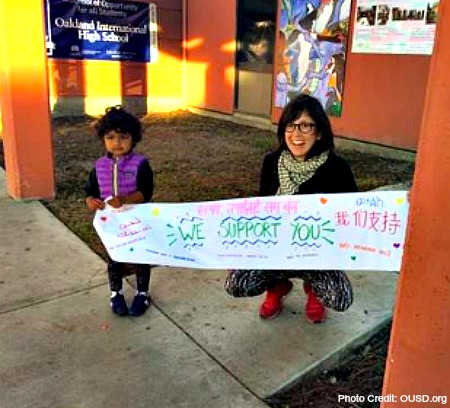The US has over 11 million undocumented people living across the States. Some major cities such as New York, Los Angeles and the San Francisco Bay Area, protect undocumented individuals by making their city a sanctuary place to live in. This means that the city limits its cooperation with the federal government effort to enforce immigration law. Sanctuary schools and districts also limit the cooperation with federal government efforts by withholding personal data collected on students and families, for example.
ICE (Immigration and Customs Enforcement) raids and deportations have caused fear in the communities across the nation. In February, in just a span of four days, ICE arrested 232 undocumented residents in the Bay Area. The impact that these raids have had on students and their families goes beyond their personal lives. This has impacted students’ ability to fully participate in their education, it has affected their ability to learn in our classrooms causing worrisome and distraction.
The education reform advocacy group, The Education Trust–West, released a report, which explains that in California alone, 250,000 students enrolled in school are undocumented, and one in eight schoolchildren have parents who are undocumented.
How are our public schools making sure that these students and families are safe on their campuses and that their information is confidential and secure?
On Oakland Unified School District’s (OUSD) website they inform families, “Oakland is a Sanctuary City and OUSD is a Sanctuary District. We do not ask for or require proof of legal immigration status upon enrollment, nor is any such information gathered by a school. Hundreds of undocumented, newcomer and refugee students are thriving in our schools with help of the Office of English Language Learners and Multilingual Achievement (ELLMA) and we want to keep it that way.”
Taking a stand like OUSD is a great start. There is so much more that districts across the country can do to continue to keep their families’ and students’ information and status protected.
1. Questions on Enrollment forms: Eliminating questions on applications or enrollment packets that may suggest that a student or their family may be undocumented. Information that isn’t needed for funding purposes should undoubtedly be removed from any enrollment forms. For example, Oakland Unified Schools district has its application available online. Question 8b asks for “Student entry date to U.S.” and question 8c asks for “Student entry date to U.S. school.” These questions may not only bring fear to undocumented newcomers when applying to the district but could be problematic information to keep on record.
2. Training Staff: Office staff and school leadership at every campus should be trained on what to do in case ICE agents show up to their school. What they as school staff are legally able to do to protect families and students is extremely important. For example, schools are identified as sensitive locations and ICE agents are not able to make an arrest or force to make an arrest on campus without warrant issued by a judge. Knowing the difference between a warrant issued by a judge and an ICE warrant are crucial in these circumstances and it is very important for school staff to know the information that can help protect their students and their families. OUSD has very helpful resources for staff and families online. Specifically, their training for staff is readily available on their website.
3. Funding Community Resources: Districts can allocate money towards funding personnel in the district who can lead partnerships and collaboration with community organizations and funnel immigration resources to schools. A district staff member can partner with community organizations and law firms who can provide important information and guidance on immigration rights such as know your rights workshops or legal aid through citizenships processes, etc. Students and families living in fear of deportation or getting arrested are more likely to attend a know your rights workshop presented at their child’s school than seek out for it themselves.
It is no longer enough to declare a school or district to be a “sanctuary space.” As educators, we need to take stand and truly do everything in our power to protect our students and our families. Together we can take preliminary measures and support our undocumented community on our campuses. Together we stand.
Melissa Salgado
Latest posts by Melissa Salgado (see all)
- Fundadores Latinos Son Importantes: Joel Portillo Comienza Una Nueva Escuela KIPP Preparatoria en el Área de la Bahía - November 7, 2019
- Latino Founders Are Important: Joel Portillo Starts New KIPP Bay Area High School - October 23, 2019
- Cómo Construir una Cultura de Colaboración Entre Padres y Escuelas - August 13, 2019
- How to Build a Collaborative Culture Between Parents and Schools - August 8, 2019
- Seleccionando la Escuela Preparatoria Correcta: Consejos de Una Consejera de Colocación, de Escuela Preparatoria - July 11, 2019

